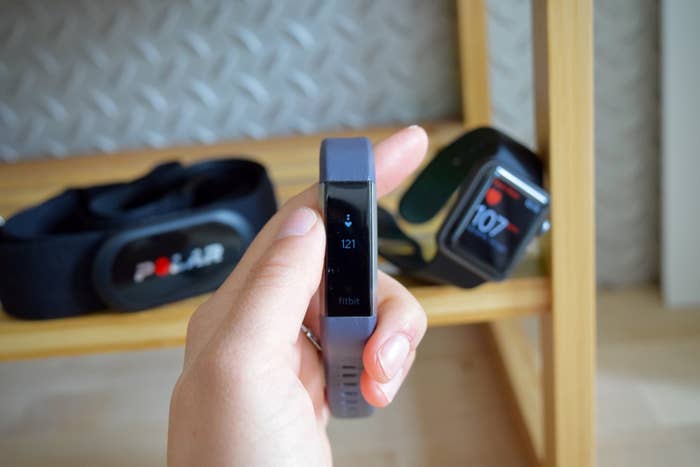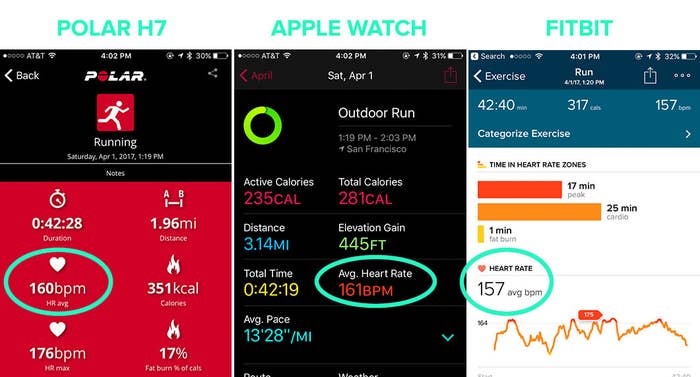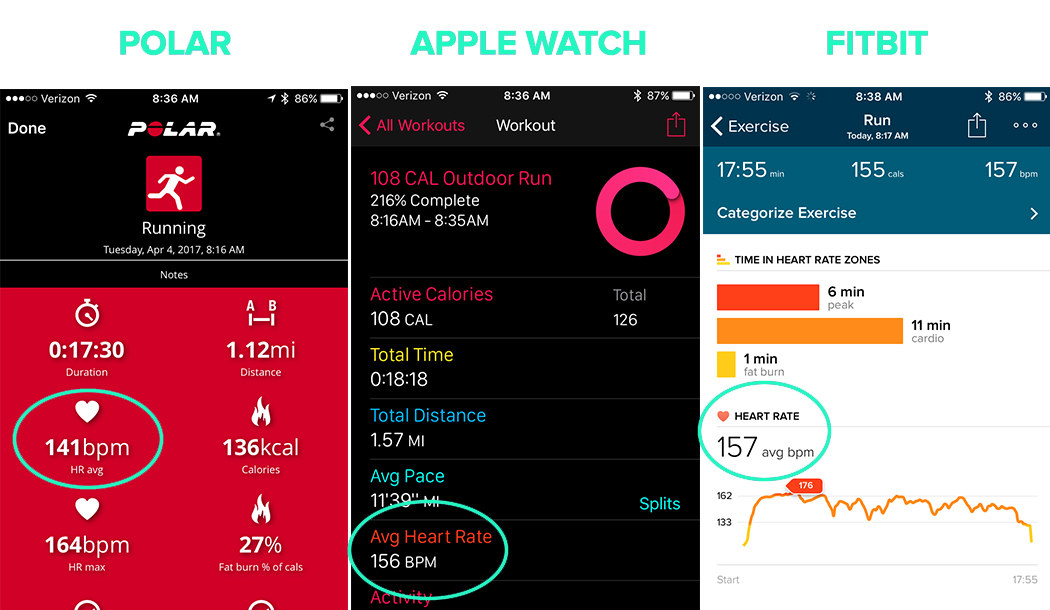
How We Tested
Unfortunately, we didn’t have access to an electrocardiograph, a medical device that’s considered the gold standard for heart rate measuring. Instead we used the next best thing — a chest strap monitor, which multiple studies have shown to be significantly more accurate than wrist-based heart rate monitors — as our control. And we enlisted Open Lab Fellow/chart master Lam Vo to help us sort through all of the data.
For each run and bike ride, we wore a Polar H7 chest strap, in addition to the Fitbit Alta HR and Apple Watch. Nicole wore the devices on different wrists, while Stephanie wore the devices on the same wrist.
Nicole's Long-ish Run: A Close Look at the Data

The Fitbit and chest strap appear to agree for most of the workout, especially during the more moderate sections, where my heart rate is between 140 and 160 bpm. When my heart rate begins to pick up, however, (around 13:30, 13:35, and 13:51) the Fitbit band is slow to catch up with my increasing heart rate. In some cases, the difference is 20 beats per minute off from the chest strap.
What’s more surprising was how close the Apple Watch’s readings were to the Polar H7. Towards the end of my run, however, the Apple Watch tended to overestimate my heart rate by about 4 bpm.
How the Alta HR Performed During Other Activities

Does Heart Rate Even Matter?
The truth is, however, most people don’t need the Alta HR, or any other wearable, to be quite that exact, experts say.
Knowing your precise heart rate during workouts is probably most useful if you fall into one of two camps: You have a heart condition, or you’re a hardcore athlete. In the first case, you’d want to avoid pushing yourself beyond your safety zone, and in the other, you’d want to make sure your heart was pumping at a high-enough intensity to adequately prepare for, say, a marathon.
Otherwise, “if you’re young and healthy, you don’t need to know your heart rate,” Marc Gillinov, a cardiac surgeon at the Cleveland Clinic in Ohio, told BuzzFeed News. “You might find it interesting — it’s not bad to know your heart rate — but it has no likely health benefits to you or me.”
That said, experts say a strong indicator of your heart health is your average resting heart rate, which is the number of times your heart beats per minute when it’s at rest (like before you get out of bed in the morning). And the Alta HR, in our experience, handles this just fine.
“If someone measures your resting heart rate as 110, that’s probably indicative that something is not good,” Gillinov said. “Alternatively, if you measure your resting heart rate as 60, it’s probably good news.”
This figure can be especially motivating for novice gym members. “As you continue to exercise more consistently, you might find your heart becomes more efficient and your resting heart rate is lower,” Heather Milton, senior exercise physiologist at NYU Langone’s Sports Performance Center, told BuzzFeed News. “It’s an objective measure of your fitness level.” Conversely, athletes can also use this knowledge to see if they’re training too hard without sufficient recovery time, leading their resting heart rates to be too high.
Chest Strap vs. Wrist-based Heart Rate Monitors: Which Is Better?
There’s a pretty obvious reason why even the best wrist-worn heart rate monitors usually aren’t as reliable as chest straps: they’re not right on top of your heart, measuring its electrical activity.
But a Fitbit or similar wristband, which is “a little bit downstream from your actual heart rate,” instead measures your blood flow as a proxy, Gillinov said. Its sensor shines a light into your skin, and the amount of light reflected back is proportional to the amount of blood flowing in and out, which varies with your pulse.
In a recent research letter in JAMA Cardiology, Gillinov and his colleagues had 50 healthy adults wear various wearables while running on treadmills at different speeds. In an experience similar to ours, the Cleveland team found that the Charge HR (which shares the same heart rate tracking technology as the Alta HR) tended to underestimate heart rate during more vigorous exercise.
Another reason a wrist-based reading might be off is because if your wrist moves during a workout, the band can slide up and down your arm and miss some beats. And if your heart is working at a very high intensity, it might produce some irregular beats that would go unnoticed by the tracker, Milton said.
So, Which Tracker Should You Buy?
It ultimately depends on your goals.
If you’re a cardiac patient, an endurance athlete, or just someone looking for the most accurate reading possible, consider getting a chest strap. Milton’s personal preference is a Polar chest strap paired with the Polar Beat or Polar Flow apps for tracking progress. The Polar H7 ($80) and newer H10 ($90) are what we used for testing the Alta HR’s heart rate accuracy.
In terms of wearables, Milton says she trusts Garmin watches. “Anecdotally, every client’s reading has been spot on," she said. "I measured their VO2 Max, and the watch is within 1 millimeter per kg per minute." VO2 Max is the maximum amount of oxygen your body can use during exercise and is typically measured with lab equipment, but wearables like Garmin can estimate your VO2 Max using heart rate data provided during a workout and other statistics like age and gender.
From our own testing, it seems the Apple Watch performed very closely to the chest strap for most runs. Still, like the Alta HR, the watch was less accurate during high-movement workouts, like bumpy bike rides.
All that said, if you’re someone who’s just getting into exercise, Fitbit’s new wearable might be what you want. A wearable like the Alta HR is a sufficient measure of your average resting heart rate, which is an indication of your overall heart health, and the intensity of a workout, which is important to keep up if you’re trying to burn fat.


